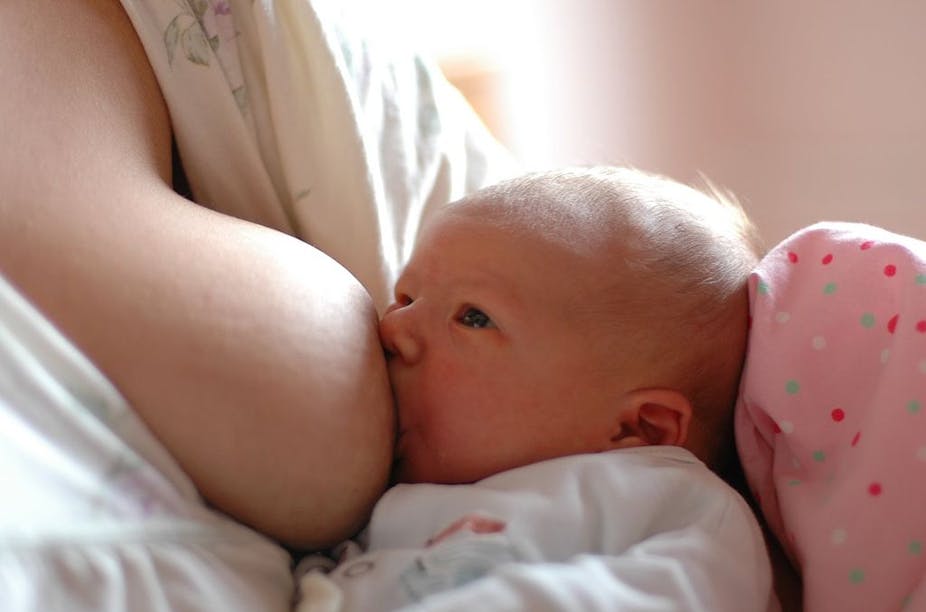Breastfeeding children boosts their chances of climbing up the social ladder – and makes it less likely they’ll slip back down.
The number of new mothers attempting to breastfeed has fallen in England for the first time in almost a decade. New figures from the Department of Health suggest that nearly 6,000 less women initiated breastfeeding in 2012-13 than the year before and about 330,000 women had stopped breastfeeding by six to eight weeks, though it is recommended to feed babies for the first six months.
But breastfeeding has a number of benefits from better immunity and brain development in a developing child. And now there is also evidence that breastfeeding can affect how we move up and down the social hierarchy.
Upwardly mobile
Using information collected on two large groups of individuals - more than 17,000 born in 1958 and 16,500 born in 1970 - we were able to track their progress from birth, through various different stages of their lives to see how their social status changed over time.
As the recent drop in the number of women breastfeeding shows, women’s choices can change significantly. In 1958, more than two-thirds of mothers breastfed their children compared with just over one in three in 1970.
But despite this significant difference, the “breastfeeding effect” was the same for both groups we studied. This effect increased a child’s odds of improving their social status by 24% and reduced it going down by about 20%.
Accounting for other factors
Our study, published in the Archives of Disease in Childhood, asked mothers whether they had breastfed for four weeks or more, less than four weeks or not at all. We then used the father’s social class when children were around the age of 10 and 11 and compared it to the children’s social class when they were aged 33 and 34.
Of course there are many factors that influence how upwardly mobile we are and this also changes over time. Educational opportunities for example. Children born in 1970 were more likely to be upwardly mobile and less likely to be downwardly mobile than those born in 1958.
In 1970, mums from more advantaged households were much more likely to breastfeed than more disadvantaged mothers, whereas the social differences were not so great in 1958.
Nonetheless, when these background factors and many others were accounted for children who had been breastfed were consistently more likely to have climbed the social ladder than those who had not been breastfed - and consistently less likely to slip down later in life.
It’s not the first time that a correlation has been found between breastfeeding and upward social mobility, but the size of the study is significantly bigger than a previous study and it’s the first time we’ve found a link to downward social mobility.
Statistical modelling
More advanced statistical methods allowed us to take account of the fact that children who are breastfed have, on average, all sorts of social, biological and economic advantages that could explain both why they are breastfed and why they are able to move up the social hierarchy more easily.
This was done by matching breastfed children with non-breastfed children on a very large number of these factors, and taking out any children who couldn’t be matched.
It wouldn’t be ethical or practical to conduct a randomised trial, where mothers would be told to breastfeed or not to see what happened to their children. Nor could anyone wait 30 or 40 years for the results. But using this statistical method, and discovering that two different groups of children, born at different times and when breastfeeding levels were very different - and seeing a similar effect in both groups - helps us to be more sure of the results.
The benefits of breastfeeding

It’s difficult to pinpoint which affords the greatest benefit to the child - the nutrients found in breast milk or the skin-to-skin contact and associated bonding during breastfeeding. The evidence suggests that mothers who can’t or don’t want to breastfeed can still do their best for their child by using formula milk that contains essential fatty acids, cuddling their babies while bottle feeding and having as much skin-to-skin contact with their baby as possible.
But previous studies have found that breastfed children have fewer infections in infancy, higher cognitive scores and fewer social and emotional problem behaviours. The longer children are breastfed, the better it gets, even if breastfeeding is combined with solids.
However, over a longer period children need a more varied diet and there’s some suggestion that the benefits of breastfeeding decline for children fed exclusively on breast milk for a very long time.
We also investigated whether children’s brain (cognitive) development and stress scores could explain how breastfeeding was linked to social mobility. Breastfeeding enhances brain development, which boosts intellect, which in turn increases upwards social mobility. Children under greater stress are also less likely to be upwardly mobile, and breastfed children show fewer signs of emotional stress.
Based on all of this, it’s disappointing that more women aren’t being supported to breastfeed more. They can face difficulties when going back to work or feeding in public. Two years ago the Department of Health dropped funding for the 18-year-long breastfeeding awareness week campaign. Perhaps it’s time we looked at this again.

